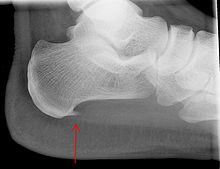So you have a heel spur? What now?
If you have had issues with your foot or ankle in the past, you may have had a xray and been told that you have a ‘heel spur’. It is a very common finding, and it’s worth knowing a little more about this. There are two main anatomical locations where a ‘heel spur’ is often found. The discussion below is specific to the ‘Plantar Calcaneal Spur’ (Spur found on the sole of the foot), rather than the ‘Achilles insertional Spur’ that may be found on the back of the heel bone, where the Achilles tendon inserts.
Let’s start with the basics. A ‘spur’ is a phrase that is often used to describe an abnormal bony outgrowth that may develop. A ‘heel spur’ specifically relates to a bony outgrowth developing from the ‘calcaneus’. Heel spurs may develop on the bottom of the heel (‘Plantar Calcaneal Spur’), and have previously been thought to be associated with the condition plantar fasciitis, given that they grow in the direction of the plantar fascia and are commonly present in people with this condition. The association and causation of plantar fasciitis is controversial. A recent review article (March 2017) published in the ‘Journal of Anatomy’, took a close look at the anatomy of the plantar calcaneal spur, and what evidence was available for its association with heel pain or plantar fasciitis.
The prevalence of plantar calcaneal spurs (PCS) is quoted as somewhere between 10-20% of the population. This increases with older age (About 50% if aged over 60), underlying arthritis (of various forms), and the presence of plantar fasciitis. The majority of PCS are anatomically found on the plantar (bottom) surface of the medial (inner) tuberosity of the calcaneus (heel bone). The plantar fascia is a dense layer of connective tissue that arises from this medial tuberosity and runs along the sole of the foot, to insert into the toes. It’s primary function is to maintain the inner arch of the foot. Numerous anatomical and histological studies have conflicted each other as to whether the plantar spur is intrinsically embedded within the plantar fascia. Other small muscles in the sole of the foot (such as the flexor digitorum brevis), also have origin within this area, however no direct and absolute link has been found. While PCS have been noted in 45-85% of patients with plantar fasciitis, a firm link has not been determined. It is estimated that only about 5% of patients who have a plantar calcaneal spur are symptomatic (i.e have heel pain).
There are several theories as to why the heel spur develops in the first place. One of these theories is based around repetitive traction/stress imparted by the plantar fascia or small muscles of the foot, resulting in inflammation and bone overgrowth. Another theory is that a PCS is a normal part of the ageing process related to a general tendency of ‘ossification’ (progression to bone development) of the ligaments in this area. At this stage, the debate rages on.
From a clinical perspective, and what you are likely to be interested in, is whether or not heel spurs cause pain? Historical studies from the 1950’s to 1970’s indicated that there was a causative relationship between heel spurs and the development of pain. Many of the surgical techniques that followed, involved surgically removing this spur. While this may sound technically straightforward, unfortunately the location of the spur requires significant soft tissue dissection to remove, and is probably not in the patient’s best interest.
With today’s available evidence, it is safe to say that although many patients with heel pain will have a plantar calcaneal spur, not all patients with heel spurs have pain. In fact, most don’t. As always, it is very important that your treating clinician has a thorough understanding of the local anatomy and what the possible pain generators may be. Often a simple solution can be found, which is in the best interest for everybody!
Easter Orthopods 2023
Easter Egg-Citement! What better way to celebrate Easter than with a competition for our nurses! Join us for a fun filled egg-citing journey to claim your prize!How to Play: If you are a nurse or staff member who works in the St Andrews theatre...
Christmas Hours
Christmas Hours Monday 21 Dec 20 - Open as usual Tuesday 22 Dec 20 - Open as usual 23 Dec 20 until 10 Jan 21 - CLOSED Please contact us via email during the break so we can get back to you once the office reopens. Merry Christmas and a happy new year! Thankyou...
Business Profile Chameleon Art Rental
Recently we held a competition on our Facebook page. Some of the fantastic businesses that were highlighted are people that we have had the pleasure of meeting, or even treating over the past few years. In this case, our competition was viewed on our Instagram! Our...
Orthopaedics 360
Orthopaedics 360
P: (08) 7099 0188
F: (08) 7099 0171
Southern Specialist Centre
Orthopaedics 360
P: (08) 7099 0188
F: (08) 7099 0171
Health @ Hindmarsh
Orthopaedics 360
P: (08) 7099 0188
F: (08) 7099 0171



